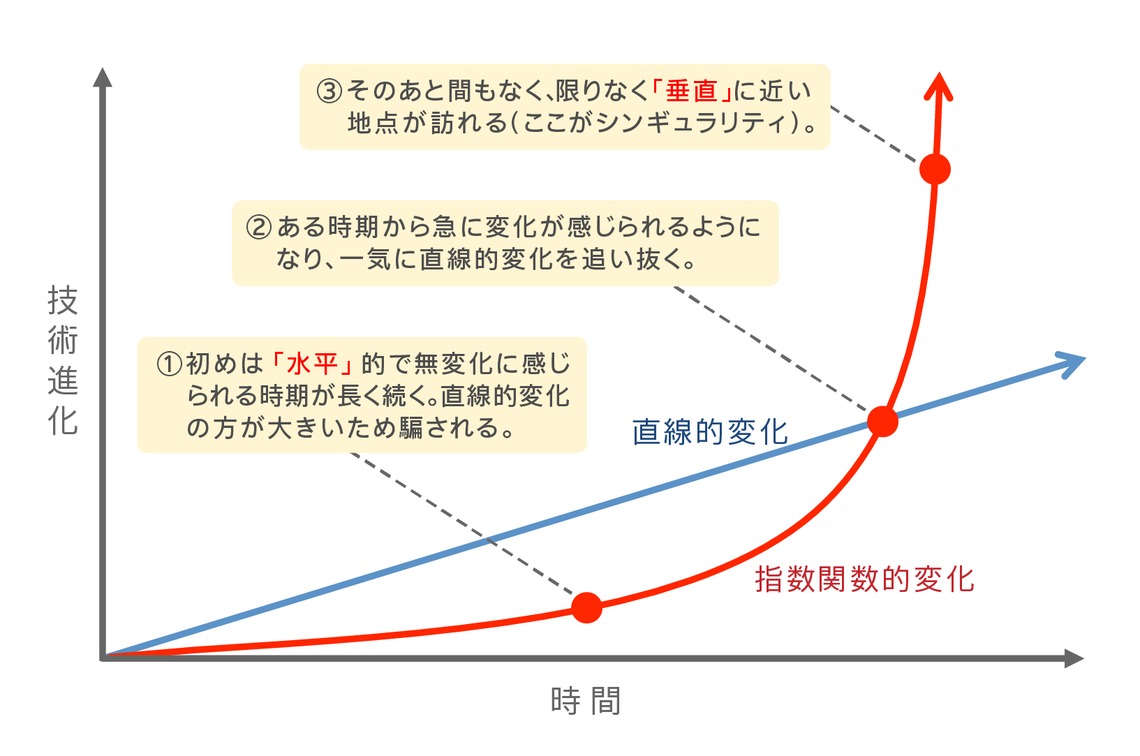How many people would have reacted to the number "2045" just two years ago? But that percentage has likely increased rapidly over the past year or so.
The "Singularity" at the heart of this theme refers to a "singular point," originally a term from physics and mathematics. It signifies a "point deviating from the normal range." For example, at the center of a black hole, there is said to be a singular point with zero apparent volume yet infinite mass.
However, the recent boom centers on the "technological singularity," a concept popularized by mathematician and science fiction writer Vernor Vinge, robotics expert Hans Moravec, and inventor and futurist Ray Kurzweil.
The fundamental principle of this worldview, epitomized by Kurzweil's "Law of Accelerating Returns," is that "technology evolves not linearly, but exponentially."
Kurzweil continues to quantitatively verify that the well-known "Moore's Law" is observable not only in integrated circuits but across all technologies, including genome analysis and communication speeds.
Exponential evolution starts slowly, with changes barely perceptible. But once a certain point (the singularity) is reached, it surges beyond human comprehension [Figure]. While Kurzweil identifies the speed of light as a bottleneck, he also suggests ways to overcome it.
After meticulously examining the pace of various technological advancements, Kurzweil predicts the real world will reach the technological singularity in "2045."
He anticipates that the convergence of three technologies—GNR (G=Genetics, N=Nanotechnology, R=Robotics)—will enable humans to overcome death and aging, lead to human-machine integration, and ultimately result in the entire universe becoming intelligent. When he published these ideas in his 2005 book 'The Singularity Is Near' (Japanese title: Singularity wa Chikai), it sparked significant debate.
Notably, Kurzweil uses "Robotics" within GNR almost synonymously with so-called "strong AI" (the concept that AI can achieve all mental functions possessed by the human brain, including self-awareness).
While such ideas likely repelled many due to their intrusion into areas like human dignity and religious beliefs, they gradually gained broad acceptance among future-oriented entrepreneurs, particularly in Silicon Valley.
For example, PayPal co-founder Peter Thiel delivered a 2009 TEDxSiliconValley presentation titled "All We Need is a Singularity." Google hired Kurzweil in 2012, and founding corporate sponsors of Singularity University—founded by Kurzweil—include Google, Cisco, and Nokia.
While the concept of the Singularity had been discussed sporadically among researchers, engineers, and Silicon Valley insiders in Japan (a notable example being its strong influence on SoftBank's "New 30-Year Vision" released in 2010), its recognition has rapidly increased in recent years, taking on the appearance of a "Third AI Boom."
Some may feel threatened by such predictions of the future, while others might dismiss them as cult-like.
However, from an industrial perspective, the truly unignorable threat may not lie in questions like "Will the Singularity actually occur?" or "Will AI surpass humans?"
These are ultimately matters of the future; what will actually happen remains unknown, and value judgments about whether to accept it or not vary from person to person.
The real threat from an industrial perspective might be that the world's most brilliant minds are fixated on this singular point beyond human comprehension, pouring enormous investments into single-mindedly "verifying" the grand "hypothesis" clearly presented by Kurzweil.
Science and technology have achieved developments that would seem like "magic" compared to the pre-Industrial Revolution era of the 18th century, but these were realized through repeated cycles of hypothesis testing.
Today, Silicon Valley sees massive IT industries born from fundamental research. The origins of the internet, GPS, Siri's voice technology, and autonomous driving lie in foundational technologies developed through industry-academia-government collaboration, such as DARPA (Defense Advanced Research Projects Agency), which were later adapted for civilian use.
Today, the distance and timeframe between industry and basic research, as seen in the scramble for AI researchers, are shorter than ever before, directly impacting profits.
Next time, building on the above, we will report on the "WIRED A.I. 2015 ~ TOKYO Singularity Summit #1" event, themed around artificial intelligence (AI), held by WIRED Japan (Condé Nast Japan) on September 29 at Toranomon Hills in Tokyo. We will pick up several topics from the event and include related information.




